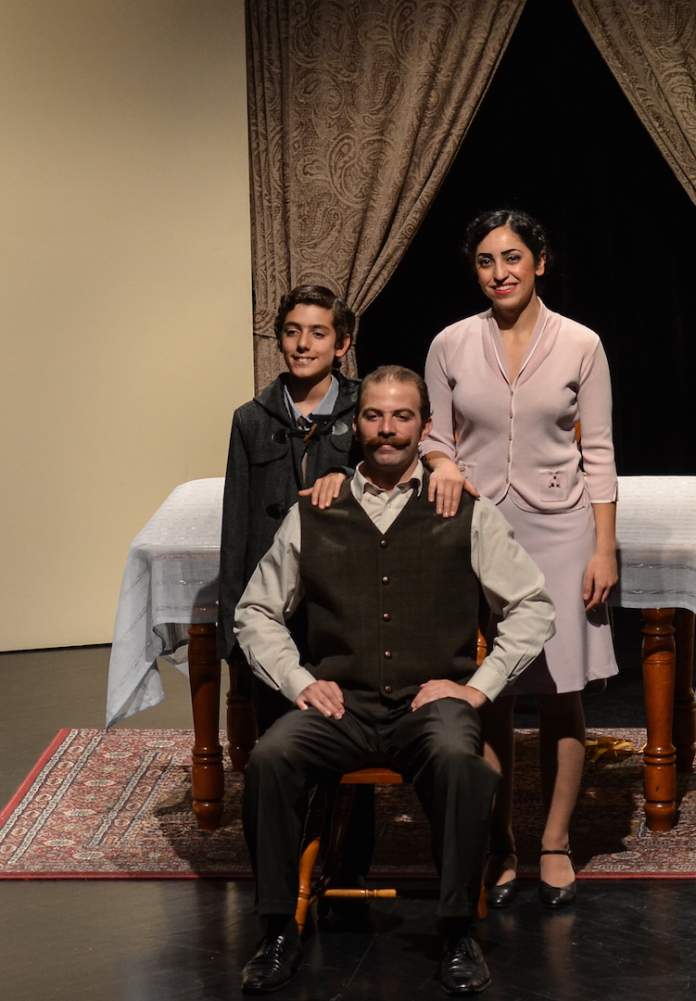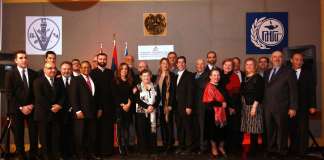As a merchandise packed in a container, he ordered her from an orphanage of his homeland, Armenia, to be delivered in the United States, the country where he settled, after a lot of suffering and melancholy, to start a family of five members replacing his own one that he lost during the genocide committed by the Turks against his people, at the threshold of the twentieth century, to eliminate the Armenians from the territories that once belonged to them.
An original vision of the Armenian Genocide expressed through intriguing and fascinating peripeteias that take place in the American society of the Roaring Twenties and the beginning of the thirties of the last century. Two critical and fateful decades that followed the abominable massacres of the Armenians. They are, also, the heart of the chaotic and tumultuous transitional period between the two world wars that seal the human history with an alarming red stamp having the color of the blood of their victims that abundantly flowed, for sinister reasons, and flooded the earth to testify and confirm that evil is a major and dominant character trait in humans.
This destructive and bloody ancestral tendency that characterizes, since the dawn of time, the behavior of the human being, and brutally expresses the vulnerability of his nature and the morbid insecurity it engenders while facing what goes beyond his understanding and his control, was the inspirer of the masterpiece of Beast on the Moon, that saw the light in the middle of the nineties of the last century, of the perspicacious and charismatic American author Richard Kalinoski.
Of Jewish ancestry, he comes from a culture impregnated with the atrocities of the ethnic exterminations that went together, since the very beginning, with the history of his people. Married to an Armenian whose family survived the ethnocide, initiated by the Turkish authorities and their accomplices, on April 24, 1915, which lasted for around two years, Kalinoski plunges into the depths of the tragic side of his era and discovers another flagrant and terrifying expression of human barbarism and savagery that assimilates the Armenians to the Jews.
Greatly touched by the similarity of the tragedies that ruthlessly strike humanity every now and then, Kalinoski puts his art and talent of a skillful dramatist, formed in the best American institutes, to serve his cause that became unveiling and underlining the absurdity and the horrifying consequences of the bloody conflicts that destroy the countries, devastate the populations and reduce the survivors into refugees scattered in the four corners of the planet where they mostly live in shabby conditions, while being deeply traumatized for coming generations.
The content of the book of Kalinoski seems, however, having no relation with its title. In the story, there is neither beast nor moon. An anecdote related by the hero of the action, in the thread of the events, elucidates, though, the intriguing mystery of the name. It confirms that the human, wherever he exists, is the tenacious enemy of what he ignores and looks risky and threatening. The American author attributes, in his work, the outbreak of violence against the Turkish Armenians to a lunar eclipse that threw its shadows, in 1893, on the fragile and shaky Ottoman Turkey of the end of the nineteenth century. It is no longer the time of its greatness and glory, but of its decadence and decline. A year smartly chosen by the author of the book, as it marks the beginning of the horrible Hamidian massacres, occurred during the reign of the Sultan Abdülhamid II (1876-1909), one of the last rulers of the Ottoman Empire whose mother was Armenian. These massacres worldwide recognized, that lasted about four years, are considered, however, according to some historical sources, as the real prelude to the great Armenian Genocide of 1915.
The eclipse of the moon, in the book of Kalinoski, was the triggering factor of the avalanche of aggressions and persecutions that hit by full force the Turkish Armenians. The Turks, feeling threatened by a quite natural phenomenon that was for them, however, completely incomprehensible and shocking, realized how vulnerable and helpless they were. Descendants of a culture characterized by the violence and the oppression, which roots run deep in the excessive use of force and fight, they did not consider any solution, to get rid from what seemed to them a real danger, other than shooting the moon with their guns, thinking that there was a giant beast walking on its surface and eclipsing its silver light, illuminating their nights, before attacking them.
The imaginary beast disappeared, however, the next day, from the night sky to reappear, this time, on their land in the person of the Armenian people whose abundant and influential community, living on the majority of the Turkish territory, formerly Armenian, suddenly seemed representing a severe threat to the Turkish identity and ambitions. The guns changed, consequently, their direction for shooting the moon, to shoot an entire race condemned, because of its distinct faith and culture, to be the redoubtable enemy that should be fully exterminated to give the Turkish leaders the sense of safety and the peace of mind.
A moving and penetrating humanitarian saga, ingeniously conceived and realized, that distinguishes by the originality of its plot, the richness, the harmony and the force of its action and the intelligence and the eloquence of its expressive dialogues that invite to the reflection and to study and analyse the characters and the various situations of the work. Though, while evoking and commemorating the souvenir of the Armenian Genocide, the story pays also a memorable and grandiose tribute to all the victims of the human injustice and brutality through time and space. It recognizes, as well, not only their pain, their suffering and their sacrifices, but also their contribution to the entire humanity that reviews, in their tragedies, its crimes and dangerous extravagances and reconsiders its vicious extremes and perilous frenzies.
A tremendous ovation of consideration and gratitude to the Center of Tekeyan, especially to its talented and devoted President, Arto Manoukian, who took the courageous and marvellous initiative to present such eminent international masterpieces that treat, ingeniously and profoundly, the critical and painful Armenian Genocide issue. Assisted by the fabulous theater group, Hay Pem, led by its exceptional and talented director, Nancy Issa Torosian, who always puts her innovative and impressive artistic touches on each of her directions, the renowned Armenian cultural center never stop taking the outstanding and amazing challenges to excel in accomplishing its mission, mainly in the current year, 2015, that commemorated, on April 24, the centenary of the Armenian Genocide. The lighthouse of the Armenian culture in Montreal continues, thus, to capture the attention, arouse the admiration and reap the sincere compliments for its devotion in wonderfully fulfilling its responsibilities, its fine selections and the superior quality of its numerous and diverse activities and productions, among them Beast on the Moon that, before being presented in French, last October, fascinated during years, in English and Armenian, a growing audience from all over the world.
Amal M. Ragheb
(Carmen Aprahamyan)
International journalist and writer














